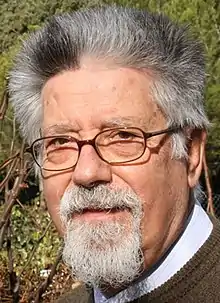Manuel García Velarde
Manuel García Velarde (pronounced [maˈnwel ɣaɾˈθia βeˈlaɾðe]; born 14 September 1941) is a Spanish physicist and university professor,[1][2] currently a member of the Academia Europaea,[3] the Royal Academy of Doctors of Spain[4] and the European Academy of Sciences.[5] Velarde has worked in American and European universities and research organizations, focusing on fluid dynamics and other non-linear problems, including the kinetic and thermodynamic theories, hydrodynamic and interfacial instabilities, anharmonic lattices and electronics.[6]
Manuel García Velarde | |
|---|---|
 | |
| Born | 14 September 1941 |
| Nationality | Spanish |
| Occupation(s) | physicist and university teacher |
| Spouse |
María del Pilar Ibarz Gil
(m. 1965) |
| Awards | See Awards |
| Signature | |
Because of his research achievements and international cooperation, he received the insignia of Officer of the National Order of Merit of France,[7] belongs to the Ordre des Palmes Académiques, and holds the Blaise Pascal Medal[8] and the Medal of the Royal Spanish Society of Physics.[9]
Life
Velarde was born in Almería, Spain, on 14 September 1941. In 1963 he graduated in physics at the Complutense University of Madrid and, thanks to a scholarship, started to work at the Junta de Energía Nuclear (JEN), precursor of the Centro de Investigaciones Energéticas, Medioambientales y Tecnológicas (CIEMAT).[1]
In 1965 he left the JEN, married María del Pilar Ibarz Gil and decided to work for a PhD degree. Influenced by Ilya Prigogine, he ended up getting two PhD degrees, one in 1968 at the Complutense University of Madrid and another in 1970 at the Université Libre de Bruxelles, which allowed him to work both in the Spanish academic world and abroad. From 1969 to 1971 he worked at the University of Texas at Austin, where Prigogine led a research institute.[1][2]
Back in Spain, in 1971 Velarde started to teach and research at the Autonomous University of Madrid, where he created the Department of Fluid Physics. In 1979 he started to work at the National University of Distance Education, where he created the Department of Physics, and in 1993 he returned to his alma mater, the Complutense University of Madrid, where he worked as a full professor and co-founded the Instituto Pluridisciplinar.[1]
From 1995 to 1997 he was vice-president and, from 1997 to 1999, president of the European Low Gravity Research Association.[10]
Throughout his career, García Velarde has held visiting or invited positions at the universities of Paris-Sud, Pierre and Marie Curie, London, Aix-Marseille, Grenoble, Huazhong, Sofia, Stanford, Cambridge, UC Berkeley, UC Santa Barbara, UC Irvine, Paris-Est Marne-la-Vallée, Libre de Bruxelles, Norwegian of Science and Technology and East China Normal, apart from institutions such as Los Alamos National Laboratory, the Saclay Nuclear Research Centre and the International Center for Mechanical Sciences, of which he was rector from 2002 to 2004.[11][1]
Awards
- 1991: Academia award of the Spanish Royal Academy of Sciences[12]
- 1994: Doctor honoris causa of Aix-Marseille University
- 1994: Ordre des Palmes Académiques
- 1996: Médaille Rammal of the Société Française de Physique and the Fondation de l'École Normale Supérieure[13]
- 2003: Premio DuPont de la Ciencia[14]
- 2006: Medal of the Royal Spanish Society of Physics[9]
- 2010: Doctor honoris causa of Saratov State University
- 2013: National Order of Merit of France[7]
- 2015: Blaise Pascal Medal in Physics[8]
- 2015: Doctor honoris causa of the University of Almería[15]
References
- "Manuel García Velarde, CV" (PDF). Madrid: Complutense University of Madrid. 27 Dec 2017. Retrieved 24 May 2019.
- Rubio, Ramón G.; Ryazantsev, Yuri S.; Starov, Victor M.; Guo-Xiang, Huang; Chetverikov, Alexander P.; Arena, Paolo; Nepomnyashchy, Alex A.; Ferrus, Alberto; Morozov, Eugene G., eds. (2013). Without bounds: a scientific canvas of nonlinearity and complex dynamics. Springer. pp. 3–54. ISBN 9783642340703.
- "Academy of Europe: Velarde Manuel". www.ae-info.org. Academia Europaea. Retrieved 24 May 2019.
- "Manuel García Velarde - Real Academia de Doctores de España". www.radoctores.es (in European Spanish). Real Academia de Doctores de España. Retrieved 24 May 2019.
- "European Academy of Sciences - Manuel Garcia Velarde". www.eurasc.org. European Academy of Sciences. Retrieved 24 May 2019.
- "MANUEL GARCIA VELARDE - Google Scholar Citations". scholar.google.com. Google Scholar. Retrieved 29 May 2019.
- "Condecoración de Manuel García Velarde". Ambassade de France en Espagne / Embajada de Francia en España (in Spanish). Retrieved 24 May 2019.
- "European Academy of Sciences - EURASC Awardees". www.eurasc.org. European Academy of Sciences. Retrieved 24 May 2019.
- "Real Sociedad Española de Física - Galardonados con la Medalla de la RSEF". rsef.es (in European Spanish). Real Sociedad Española de Física. Retrieved 24 May 2019.
- "Committee – ELGRA – European Low Gravity Research Association". www.elgra.org. European Low Gravity Research Association. Retrieved 1 June 2019.
Manuel G. Velarde (1997–1999)
- "CISM • Governance". www.cism.it. International Center for Mechanical Sciences. Retrieved 1 June 2019.
The Former Rectors: Giulio Maier (I), Friedrich Pfeiffer (D), Jean Salençon (F), Franz G. Rammerstorfer (A), Mahir Sayir (CH), Wilhelm Schneider (A), Manuel G. Velarde (E).
- C., S. (16 October 1991). "La Real de Ciencias comienza hoy el nuevo curso académico". hemeroteca.abc.es (in European Spanish). Madrid: ABC. p. 69. Retrieved 31 May 2019.
La Real Academia de Ciencias Físicas, Exactas y Naturales, [...] En el transcurso de este acto, que tendrá por escenario la sede de la Corporación, se procederáa la entrega de los siguientes galardones: Premios Academia 1991 a los profesores Manuel García Velarde y David Nualart Rodón,
- "SFP : Prix depuis la création jusque 1998". sfp.in2p3.fr. Société Française de Physique. Retrieved 29 May 2019.
1996 VELARDE Manuel
- "El catedrático García Velarde, ganador del Premio DuPont". La Voz de Galicia (in Spanish). 5 September 2003. Retrieved 29 May 2019.
- "El físico almeriense Manuel García Velarde, nuevo doctor honoris causa de la UAL". www.europapress.es. Europa Press. 27 September 2019. Retrieved 22 January 2020.